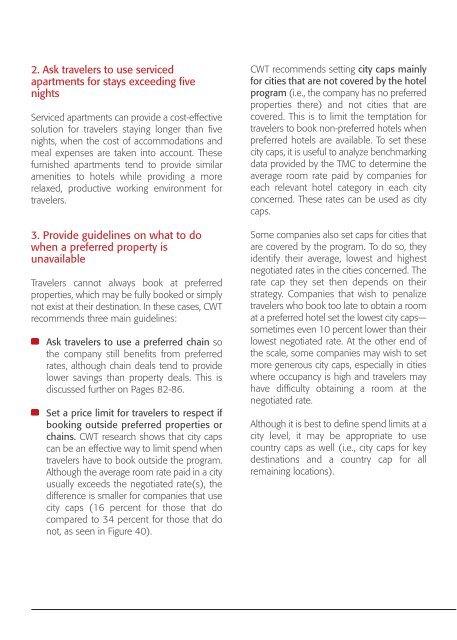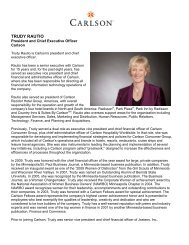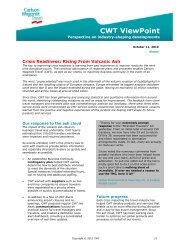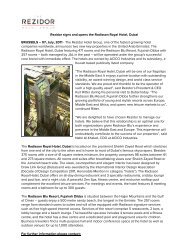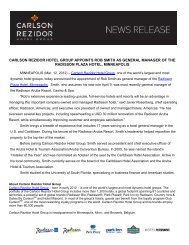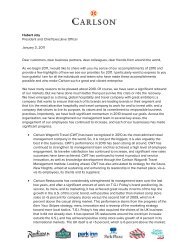Room for Savings: Optimizing Hotel Spend - Carlson
Room for Savings: Optimizing Hotel Spend - Carlson
Room for Savings: Optimizing Hotel Spend - Carlson
Create successful ePaper yourself
Turn your PDF publications into a flip-book with our unique Google optimized e-Paper software.
2. Ask travelers to use serviced<br />
apartments <strong>for</strong> stays exceeding five<br />
nights<br />
Serviced apartments can provide a cost-effective<br />
solution <strong>for</strong> travelers staying longer than five<br />
nights, when the cost of accommodations and<br />
meal expenses are taken into account. These<br />
furnished apartments tend to provide similar<br />
amenities to hotels while providing a more<br />
relaxed, productive working environment <strong>for</strong><br />
travelers.<br />
3. Provide guidelines on what to do<br />
when a preferred property is<br />
unavailable<br />
Travelers cannot always book at preferred<br />
properties, which may be fully booked or simply<br />
not exist at their destination. In these cases, CWT<br />
recommends three main guidelines:<br />
Ask travelers to use a preferred chain so<br />
the company still benefits from preferred<br />
rates, although chain deals tend to provide<br />
lower savings than property deals. This is<br />
discussed further on Pages 82-86.<br />
Set a price limit <strong>for</strong> travelers to respect if<br />
booking outside preferred properties or<br />
chains. CWT research shows that city caps<br />
can be an effective way to limit spend when<br />
travelers have to book outside the program.<br />
Although the average room rate paid in a city<br />
usually exceeds the negotiated rate(s), the<br />
difference is smaller <strong>for</strong> companies that use<br />
city caps (16 percent <strong>for</strong> those that do<br />
compared to 34 percent <strong>for</strong> those that do<br />
not, as seen in Figure 40).<br />
CWT recommends setting city caps mainly<br />
<strong>for</strong> cities that are not covered by the hotel<br />
program (i.e., the company has no preferred<br />
properties there) and not cities that are<br />
covered. This is to limit the temptation <strong>for</strong><br />
travelers to book non-preferred hotels when<br />
preferred hotels are available. To set these<br />
city caps, it is useful to analyze benchmarking<br />
data provided by the TMC to determine the<br />
average room rate paid by companies <strong>for</strong><br />
each relevant hotel category in each city<br />
concerned. These rates can be used as city<br />
caps.<br />
Some companies also set caps <strong>for</strong> cities that<br />
are covered by the program. To do so, they<br />
identify their average, lowest and highest<br />
negotiated rates in the cities concerned. The<br />
rate cap they set then depends on their<br />
strategy. Companies that wish to penalize<br />
travelers who book too late to obtain a room<br />
at a preferred hotel set the lowest city caps—<br />
sometimes even 10 percent lower than their<br />
lowest negotiated rate. At the other end of<br />
the scale, some companies may wish to set<br />
more generous city caps, especially in cities<br />
where occupancy is high and travelers may<br />
have difficulty obtaining a room at the<br />
negotiated rate.<br />
Although it is best to define spend limits at a<br />
city level, it may be appropriate to use<br />
country caps as well (i.e., city caps <strong>for</strong> key<br />
destinations and a country cap <strong>for</strong> all<br />
remaining locations).


